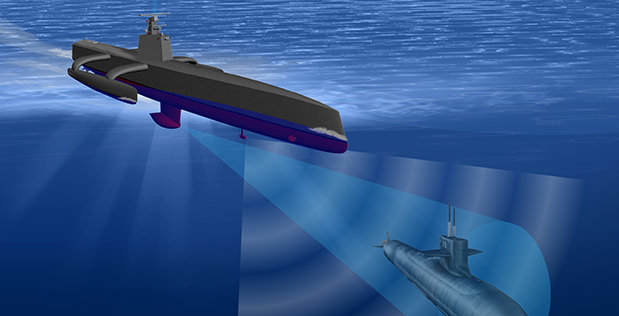DARPA is christening its autonomous robot ship in April, the agency’s director, Arati Prabhakar, has revealed at a media roundtable.
The Obama administration requested $2.973 billion for DARPA for fiscal year 2017, the same amount in its 2016 request, and $105 more than what was appropriated, said DARPA Director Arati Prabhakar. That amounts to only 2 percent of federal R&D expenditures, but the organization has had a large impact, she added.
“We are an organization that has been designed from the beginning to take risk and manage risk in pursuit of off-scale impact,” she said.
The funding will go toward three major strategic areas: rethinking complex military systems; mastering the information explosion; and developing the seeds of new technological surprise, she told reporters Feb. 10 during a briefing at DARPA headquarters in Arlington, Virginia.
As for the first category, Steve Walker, DARPA deputy director, said, “We need to continue to think how to build highly capable military systems, especially to prepare for fights with highly capable adversaries.”
The military can’t continue to rely on big, monolithic weapons systems that take years to develop. It will never have them in time or in the numbers required to fight advanced adversaries, Walker said.
“We need to mix it up. We need to build war-fighting architectures that are more heterogeneous in nature, hard to target and rely on smaller and cheaper microelectronics technologies,” he said.
One example is the Anti-Submarine Warfare Continuous Trail Unmanned Vessel which will be the largest unmanned surface vehicle ever built at 130-feet long, Walker said. It will be christened in April in Portland, Oregon, and then begin to demonstrate its long-range capabilities over 18 months in cooperation with the Office of Naval Research and the Space and Naval Systems Warfare Command.
“Imagine an unmanned surface vessel following all the laws of the sea on its own and operating with manned surface and unmanned underwater vehicles,” Walker said.
“We think the real cost savings will be in operating this vessel at sea compared to how we operate vessels today,” he added. It could be used for counter-mine missions, reconnaissance and resupply, he added.
Another program is the distributed battle management system, which is intended to exchange information even in a jammed environment, he said.
DARPA also has a goal to launch 100 satellites in a 10-day period with its XS-1 reusable launch system. “You can imagine an adversary doing something offensive in space and having that kind of responsive capability,” Walker said.
In the commercial world, there would be tremendous savings for launching that number of spacecraft in that amount of time, he added. More and more, the technologies the agency develops aren’t exclusively for the military. DARPA was an early backer of SpaceX and its Falcon rocket system. It’s a commercial launch provider, but its lower cost services are now benefitting the military, he noted.
The second category, mastering the information explosion, is separated into two categories: big data for security problems and cybersecurity, Prabhakar said.
In big data, DARPA wants to “empower the end users of data with tools that allow them to create deep value from all these bytes that are just flying at them,” she said. The MUSE program, Mining and Understanding Software Enclaves, is a big data approach to writing software.
As for cybersecurity, “attack entry points are growing,” she said. “We don’t think there is a silver bullet but we believe that major advances can be made.”
One idea is to “take whole classes of vulnerabilities off the table” in the High Assurance Cyber Military System. Defense Department systems are “chock full of embedded processors,” she said. They may not appear to be connected to the network, but there are ways in, Prabhakar said.
One experiment created a new secure microkernel chip, which was placed in the mission computer of a Little Bird helicopter for a “cyber retrofit.” The chip gave the computer a new security foundation. A red team of hackers tried everything they could to get in the system, but couldn’t. “We made it as easy for them as we could and even gave them source code, but they were not able to break into the system,” Prabhakar said. They were then given full access to one of the applications, a camera, but still couldn’t bust into the mission computer, she said.
The third category, “developing the seeds of new technological surprise,” comprises many different disciplines and programs, she said. The AC/DC program, for example, turns chemical weapons into fertilizer, she said.
In neuroscience, the advanced prosthetics program recently had a big breakthrough when a paralyzed man — with the assistance of electrodes implanted in his cortex — could receive signals from a prosthetic arm. That allowed him to have the sensation of touch for the first time, she said.
Prabhakar said she was excited about the possibilities of the new Revolutionary Enhancement of Visibility Exploiting Active Light Fields, or REVEAL, program.
Photons that hit cameras or sensors register light intensity and spectral information. But those photons could have come from different light sources. As they go through the environment, they are bouncing off and interacting with all sorts of surfaces, she said.
“By the time they get to that sensor, they have actually had these rich and full lives,” Prabhakar said.
REVEAL will see if sensors can capture much more of the information that those photons are bringing — time of arrival, angle of arrival and other characteristics — which may show what is behind an object, or be able to create 3D models of the scene, she said.
Agencies/Canadajournal

 Canada Journal – News of the World Articles and videos to bring you the biggest Canadian news stories from across the country every day
Canada Journal – News of the World Articles and videos to bring you the biggest Canadian news stories from across the country every day

